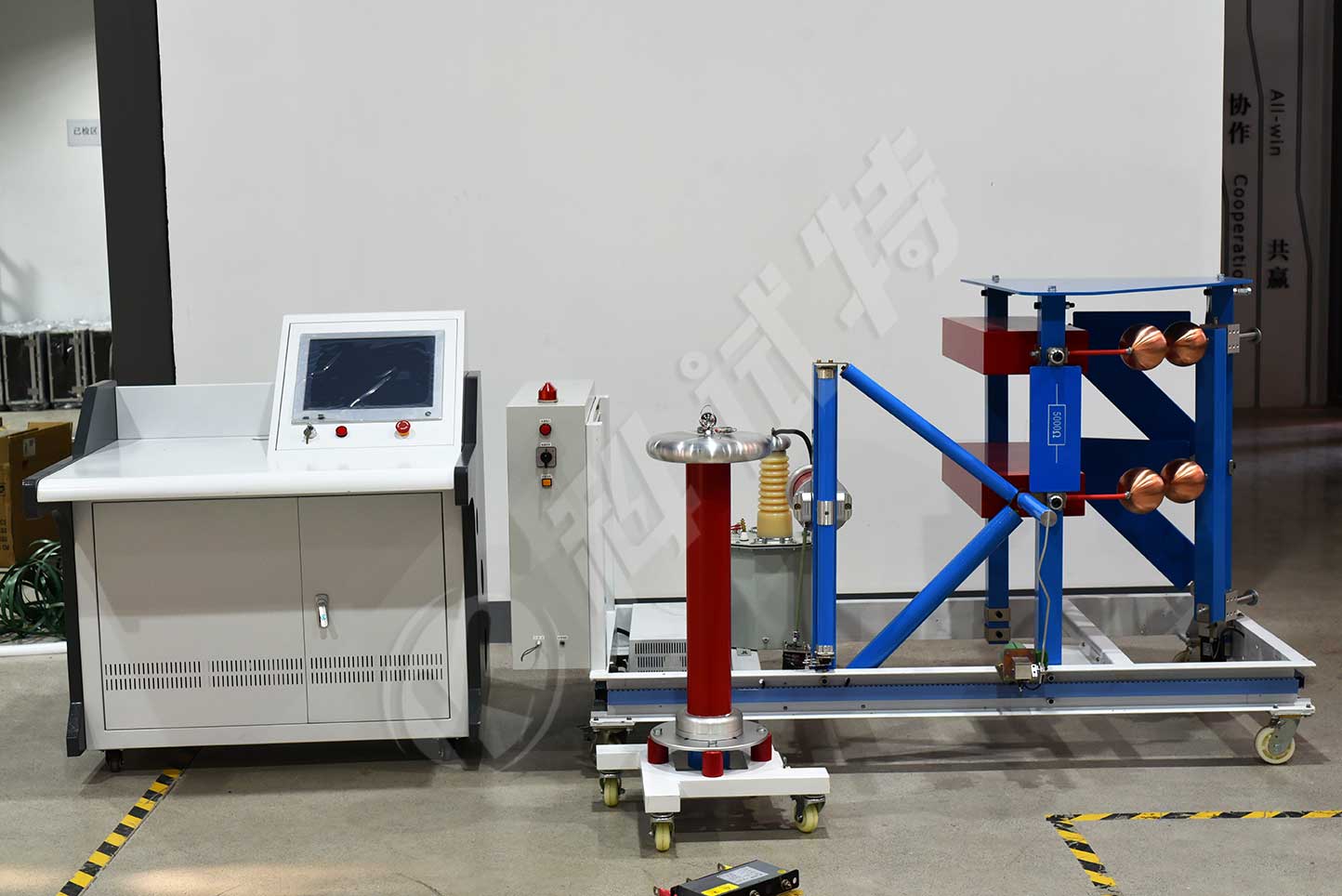The lightning impulse test device is an experimental equipment used to simulate lightning impulse, which plays an important role in multiple fields such as power, electronics, aerospace, and military. The following introduces the device principle, application scenarios, typical configurations, technical parameters, and development trends:
1. Device principle
The lightning impulse test device simulates lightning impulse waves in nature to test electrical equipment, materials, and systems, in order to evaluate their performance and tolerance under lightning impulse. The core components and working principle are as follows:
① High voltage charging power supply: provides stable DC power for capacitors and is the energy input terminal.
② Energy storage capacitor: It stores electrical energy during the charging phase and releases energy at the moment of discharge, and is a key component for generating high-voltage pulses.
③ Trigger switch: Control the timing of capacitor discharge to ensure precise and controllable discharge process.
④ Waveform forming network: composed of components such as resistors and inductors, used to adjust the output voltage waveform to meet standard or user-defined requirements. Typical waveforms include standard 8/20 μ s (current waveform) and 1.2/50 μ s (voltage waveform).
⑤ Measurement system: including voltage dividers, oscilloscopes, etc., used to record and analyze output waveforms, providing data support for evaluating test results.
2. Application scenarios
① Power system insulation testing: used to evaluate the insulation performance of power equipment such as transformers, cables, and switchgear under lightning strikes, ensuring that they can withstand the impact of lightning overvoltage in actual operation and ensuring the safe and stable operation of the power grid.
② Performance evaluation of lightning arresters: By simulating lightning strikes, the operational characteristics and protective effects of lightning arresters are tested to ensure that they can effectively protect electrical equipment from lightning damage during actual operation.
③ Reliability testing of electronic devices: Conduct lightning impulse tests on electronic devices such as computers, communication equipment, and household appliances to evaluate their performance, reliability, and tolerance in lightning environments, and improve the lightning protection design level of electronic devices.
④ Aerospace equipment testing: used to test the reliability and tolerance of aircraft electronic equipment, satellite equipment, and other aerospace equipment under adverse weather conditions, ensuring their normal operation in extreme environments such as lightning.
⑤ Building lightning protection testing: testing whether the lightning protection system of a building can effectively protect the building from lightning strikes and ensure the safety of personnel and equipment inside the building.
⑥ Military weapon and equipment testing: testing the anti-interference performance of military weapons and equipment against lightning strikes, and improving the combat capability of military equipment in complex electromagnetic environments.
3. Typical configuration
Taking the fully automatic lightning impulse voltage testing system as an example, its configuration usually includes:
① Lightning impulse voltage generator body: the core equipment that generates high-voltage impulse waves.
② Low damping lightning impulse capacitive voltage divider: used for measuring high voltage impulse voltage, with high accuracy, such as an accuracy of up to 1.0%.
③ The computer fully automatic control system for lightning impulse voltage test: realizes the automation control of the test process, improves the efficiency and accuracy of the test.
④ Fully automatic digital lightning impulse measurement and analysis system: Analyze and process measurement data to generate detailed test reports.
⑤ Wave adjusting resistor and accessories: used to adjust the parameters of the impulse voltage waveform to meet different test requirements.
⑥ Automatic rectification charging power supply device: provides stable charging power for capacitors, ensuring the stability and reliability of the charging process.
4. Technical parameters
Waveform parameters: The standard lightning impulse voltage full wave parameters are usually 1.2 ± 30%/50 ± 20% μ s, with an efficiency greater than 90%.
Voltage level: Suitable for testing power products of different voltage levels, such as lightning impulse voltage testing research for power products of 35kV and below. The nominal lightning wave impulse voltage can reach ± 400kV.
Capacity: The nominal capacity (energy) varies depending on different models and applications, such as 20kJ.
Grade capacitor: Adopting dry fully insulated packaging, such as 1 μ F, 100kV (2 × 50kV -2 μ F), it has the advantage of never leaking oil or deforming.
Voltage level: generally 100kV.
Grade/capacity: such as 4/5kJ.
Output standard waveform and amplitude: It can output positive and negative polarity lightning impulse waves. When output under no-load/load (load capacitance<5000pF), the voltage utilization factor is not less than 90%.
Synchronization range: greater than 20%.
Duration of use: Can work continuously when the rated operating voltage is less than 80%; Intermittent operation is allowed when the rated working voltage exceeds 80%.
Amplitude adjustment error voltage difference: less than 1%, with a minimum output voltage not exceeding 10% of the device's nominal voltage.
Synchronization error rate: less than 1.
5. Development Trends
① High voltage testing capability: With the continuous improvement of voltage levels in power equipment, lightning impulse testing devices will develop towards higher voltage levels to meet the testing needs of ultra-high voltage and extra high voltage power equipment.
② Multifunctional: Not only can it generate standard lightning impulse voltage waveforms, but it can also generate various waveforms such as operational impulse voltage waves and truncated waves to meet the testing requirements of different types of equipment.
③ Automation and Intelligence: Advanced computer technology and automation control technology are adopted to achieve automated control and intelligent management of the experimental process, improving experimental efficiency and accuracy.
④ Safety and reliability: Strengthen the safety protection design of equipment, improve the reliability and stability of equipment, and ensure the safety of testing personnel and equipment.
⑤ Energy saving and environmental protection: adopting energy-saving power sources and high-efficiency energy storage components to reduce equipment energy consumption and minimize environmental impact.

The ZCCJ-800kV/80kJ impulse voltage generator adopts a four column H structure, with a steel bracket consisting of a single flange and a parallel external single capacitor, forming a stable structure consisting of one stage. The main equipment is of 8 levels, forming a combined tower structure, with each level stacked step by step for easy disassembly and maintenance, and the overall structure is stable.
This set of equipment is mainly designed to meet the lightning full wave and steep wave waveform tests of electrical equipment such as power insulators.The basic configuration of the equipment includes a charging device, an impulse voltage generator body, a weak damping capacitor voltage divider, a steep wave device, a fast resistor voltage divider, and other control and measurement devices.
Kvtester Electronics Technology Co.,Ltd. is a high-tech enterprise specializing in power testing, testing, research and development, production, and sales of testing equipment. It has been engaged in the electrical testing industry for many years, and its products are of high quality. We welcome customers to come and purchase. Service hotline: 0086-27-81778799, to learn more, visit the official website: www.kvtester.com





